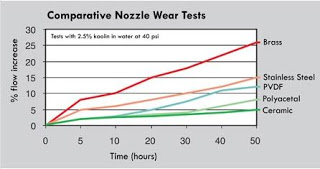One of the lowest cost items on your sprayer has the potential to waste the most money. Spray nozzle difficulties can result in a number of more serious issues such as spray drift, over application and distorted spray patterns. Ultimately nozzle troubles take away from your bottom line.
Before taking your sprayer out in the fields, it is important to check for spray uniformity among all of the nozzles. This can easily be done by spraying water on a concrete surface and observing the drying patterns. If the nozzle produces excessive accumulation in the spray pattern, a variety of minor problems could be occurring such as nozzle wear, low boom height, low operating pressure or too much nozzle spacing.
Check manufacturer recommendations on boom height, nozzle spacing and operating pressure to assure you are operating at the optimal conditions.
Irregular spray patterns can result from other sources as well including clogged nozzle tips, mismatched nozzles, uneven booms and uneven pressure consistency along the boom. Restrictions in the spray hose or a spray hose that is too small, in terms of diameter, may cause noticeable pressure differences. To check for pressure differences, it is recommended to use an accurate, quality pressure gauge.
Never use different nozzles across the boom as this can result in uneven spray patterns and a lack of coverage or over application. If a nozzle becomes clogged, it is best to blow out the dirt with a soft-bristled brush or compressed air; you should never try to blow it out with your mouth or clean with wire because the orifice can easily be damaged. Once you have determined that the pressure is even, the booms are level and all of your matching nozzles are unclogged, if you are still seeing irregular spray patterns, it may be time to replace the nozzle tips.
Inaccurate applications due to nozzle wear can waste chemicals and money, making it important to evaluate the nozzle tips. Worn nozzles produce increased flow rates resulting from an increased nozzle orifice area. It is recommended to replace nozzles if the flow rates are 10 percent or more in error.
The nozzle material is a major contributing factor to the rate of nozzle wear. Nozzle tips come in an assortment of materials including nylon, brass, stainless steel, thermoplastic, tungsten carbide and ceramic. Generally, nozzle tips manufactured from nylon or brass will wear out much quicker than ceramic, tungsten carbide and thermoplastic. Thermoplastic nozzles are noted for their resistance to harsh materials, but they are also known to swell with some chemicals. Stainless steel nozzles will typically produce a more uniform pattern over a more extended period of time.

Nozzle wear is also affected by the abrasiveness of the chemicals used for application. More abrasive substances will wear down nozzle tips much quicker than less corrosive chemicals.
Sprayer calibration is essential to checking spray nozzles and their spray patterns. To assist with sprayer calibration, a variety of calibration products are available including the Spot On sprayer calibrator, SpotOn mini-patternator and Hypro calibration jugs. The sprayer calibrator can assist you with choosing a nozzle and finding worn nozzles. The mini-patternator will help you visualize your spray pattern and spray coverage.

